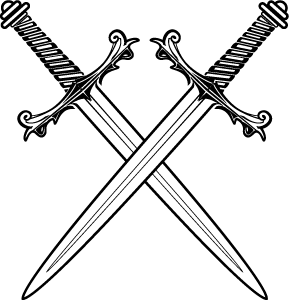Page 1

Black Dawn
Sword Compendium

I've played a large multitude of fantasy themed games. In every one of these games, however, exists
a large selection of fantasy weapons, or weapons that were used in the medieval times. First among these weapons
is undoubtedly the sword, one of the most elegant and mythical of the ancient weapons.
One may oft encounter such other weapons as the halberd, practical, and yet ugly and unwieldy; the spear, a simple
and plain weapon, not very versatile; the mace, a brutal creation, good only for blunt strikes; the bow, a powerful and
deadly weapon, but rather vulgar; or perhaps the axe, a rival of the sword in beauty, function, and versatility. But the
sword has by and large been judged superior to these all. It's smaller incarnation, the knife, still exists now as a modern
weapon. You will see it in some places as the Ka-bar knife, composed of chromium steel and carried into battle by USA
marines.
The sword is held in almost a mystic status by many cultures around the world. The classic cruciform swords are
representative of the medieval period, and the crescent-shaped scimitar to the Islamic empires. This is no coincidence.
The flexible rapier, and the classic cavalry sabre of a later period are further examples of the imprint that swords have
had on the world.
In the East, swords such as the katana were born, and in the Americas, even stranger variants were developed. However,
this page will only look at European swords from just before the Medieval period, continuing into the Renaissance, and
perhaps a few past even that period.
And without further ado ...
The
words
The Roman Gladius
The Gladius was a short sword manufactured by the Romans for their legions. In many ways,
it was an excellent sword for its purpose. It was meant to be used as a close-range infantry
stabbing weapon, as the hilt is rather diminutive, and the pommel is large. The shortsword
could not actually have been made much larger due to the bending nature of bronze (it is
manufactured from copper, a remarkably soft metal, and tin.) However the sword was used
in conjunction with the heavy Roman shield, creating a powerful and well defended infantry.
The Roman Spatha
The Spatha was an evolution of the gladius, a longer Roman sword that was developed later
into the empire. It was likely made of iron, and its design would contribute to the creation
of the arming sword. After the collapse of the Roman empire, but before the Viking
invasions, the Spatha was likely used by most militaries.
The Viking Sword
The Viking sword was of a very distinctive style, much different from the Spatha. The pommels
were similar, being of a broad, flat shape, unlike the circular pommels of later swords. The guard
was a small, slightly curved shape, offering little protection for the hand, and so obviously meant
to be used in conjunction with a shield. The blade itself was interesting, as it did not taper, running
parallel until the very tip, where it rounded off into a decidedly blunt point. This meant two things;
one that the blade was top heavy (the metal in the hilt was only the pommel, guard, and tang, so
it was light), and the blade was not good for thrusting. This meant that the blade must have been
phenomenal at slashing. Added to this was the fuller, which must have increased the speed of the
blade without decreasing its aforementioned prowess at slashing. The Ulfbehrt, a pure-steel
variant of the Viking Sword, must have been truly a marvel.
The Arming Sword
The arming sword is the classic medieval sword. It was medium length, being around four feet, and
cruciform, meaning it had a linear crossguard that ran perpendicular to the handle, making the sword
look like Jesus's cross. The pommel was likely changed from the flat, broad pommel to a circular
design. The broad pommel locks a forearm perpendicular to the bland, and so is less conducive to
slashing than a circular pommel.

